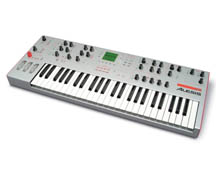INSTRUMENTAL AESTHETICS
Billy White's note about guitar aesthetics brought forth emails from musician readers, many of which picked up such TSOS themes as the nature of authenticity, the relationship between technology and aesthetics, and aesthetic improvements as a form of material progress.
Setting the stage, Bryan Castaneda passes on this quote from Wired's October cover story, "Super Producers":
" 'Our attraction to equiment has a lot to do with the way it looks', says [Tim] Goldsworthy [one half of the duo DFA]. 'You're surrounded by this stuff all the time.' Aside from a Macintosh G4 and a sequencer, DFA uses mostly predigital gear. But technology still plays a role in shaping the pair's signature sound. 'Thank God,' says Goldsworthy, 'for eBay.'"
Todd Fletcher writes:
The Les Paul post reminded me of trends among the electronic instruments that I play.
I've been playing electronic music for 20 years. Here's a picture of the first synthesizer I bought, in 1984:
And here's my latest purchase, from few months ago:
It's becoming common for manufacturers to hire European design firms to create the front panel now, something that would have seemed bizarre in 1984. The trend for style began with a Sweedish company in 1995 or so when they made a very red keyboard (prior to that, the color shemes were designed by Henry Ford, as you can see in the first picture):
Now, I wouldn't buy a lousy sounding instrument that looks great, but a great-sounding instrument that also looks great has a much better chance of getting my money.
Exactly. When technical quality is consistently good, people look for other sources of additional value--and aesthetics often tops that list.
Finally, Martin McClellan tells a fascinating story about aesthetics and authenticity:
I had to write after reading your post about the Les Paul story. I managed a very large used-guitar shop here in Seattle for nearly 7 years. Two stories came to mind while I read the post:
1. An old timer came into the shop to get some of his guitars worked on. He told us about working at the Gibson factory in the 70's. One day he was shown a flat of Les Paul bodies with the necks already glued on. Some had finish sprayed on, some didn't even have the necks shaped and curved from the raw block. His boss told him that these were flawed guitars, and his job? Run them all through the band saw. He did, he said, crying the whole time at having to destroy something so beautiful.
2. Another day a guy came in to try some amps, and with him he a large, heavy road case--the kind designed to keep a guitar safe in any type of transit. He popped it up on the counter, opened the top, and sitting there was a '58 flame top Les Paul in pretty good shape. If this were a movie, rays of golden sunlight would have shot from the case with a chorus of angels "aaaaaahhhhhhh"-ing in the background. I asked gingerly if I could inspect the guitar, and he gave his permission. I picked it up, and looked it over head to toe. Now, in the vintage guitar world, authenticity is king. A fine guitar that has been refinished could be worth considerably less than its counterpart with badly damaged original finish. Also, guitar parts are a large part of the equation--not only for value, but dating the guitar, making sure it's authentic, stock, etc. I spent 10 minutes with this guitar, and it was perfect. Every part on it was stock, the serial number and stamping impression were right, the nitro cellulose finish aged exactly as it should. The pickups, the knobs, the tuners, the wood on the neck, the flame maple on the top, the fade of the sunburst--all perfect. I'll bet if I pulled the wiring harness and looked at the potentiometers they would have a the right date too. But then I looked up at the musician and he had a thin, wry smile. "It's a fake" he said, and unscrewed the back panel that holds the electronics to show us the stamp of the maker.
Turns out there is a guy in Canada making perfect reproductions of these guitars. He makes them, ages them and sells them to people who can't afford the real deal. His price? $5000. And he's backed up for a few years, from what this musician told me. You can get a lot of guitar for that price, but maybe not a real sunburst, and if you want the real deal, this is the next best option. I always had good radar for guitars that are fake, or have been altered, and this one sent up no warning bells. It was a dead ringer for the original.
But mostly, the idea that a secondary market for these guitars that have been priced out of the reach of most professional musicians is an interesting phenomena--certainly one we see a lot with cheap (and some not-so-cheap) factory knock-offs of famous guitars. Outside of the guitar world, I think of the mass printing of famous paintings as posters, but the interesting thing about the guitars is that these aren't necessarily replicas in the standard sense, they are as much a piece of art and craftsmanship as the original Les Pauls were. They are truly a labor of love, no matter the price. They are the work of a true artisan.
Thanks to everyone who wrote in. The great thing about the subject of TSOS is no matter how much I learn about it, there's still an unexplored area--in this case, the look and feel of musical instruments.

